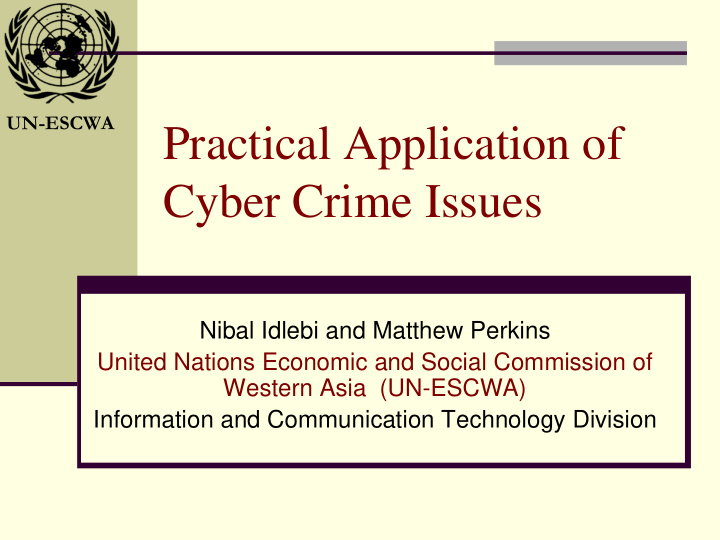



UN-ESCWA Practical Application of Cyber Crime Issues Nibal Idlebi and Matthew Perkins United Nations Economic and Social Commission of Western Asia (UN-ESCWA) Information and Communication Technology Division
Practical Applications � This presentation highlights the techniques and tools used in three realms of cyber crime: � Commission � Detection � Prevention Background UN-ESCWA
Understand the Fundamentals � In order to draft effective legislation, it is necessary to understand the technological background of cyber crime. UN-ESCWA
Legal Principles � There can be no crime without a law for it. � In order for an action to be illegal, there must be a specific law forbidding it. � Most laws applied to cyber crime are based on efforts to make old law modern. This does not tend to work very well. UN-ESCWA
How to Commit Cyber Crime � Cyber crime is a broad and complex field, with many different facets. This presentation highlights ways criminals use to break security systems, such as: Compromising passwords UN-ESCWA
How to Commit Cyber Crime � Most people choose passwords that are relatively easy for a computer to guess using a technique called “ Brute force ”. � In a brute force attack, the computer attempts to determine the password by using a large number of possibilities. UN-ESCWA
How to Commit Cyber Crime � Brute force attack is a method of defeating a cryptographic scheme by trying a large number of possibilities; for example, exhaustively working through all possible keys in order to decrypt a message. UN-ESCWA
UN-ESCWA How to Commit Cyber Crime Solar Winds
How to Commit Cyber Crime � Advantages: � Can be extremely effective at obtaining unsecure passwords. � Disadvantages: � Can take an extensive amount of time. � Easily detectable for properly configured systems. UN-ESCWA
How to Commit Cyber Crime � Other applications: Nessus vulernability scaner � Designed to automate the testing and discovery of known security problems before a hacker takes advantage of them. � Reveals problems in a network, and can be used by both administrators and hackers � Could be used by a hacker group, a security company, or a researcher to violate the security of a software product. UN-ESCWA
How to Commit Cyber Crime � Nessus vulernability scaner � Lots of capabilities. � Fairly complex � Detection of remote flaws � Scalable UN-ESCWA
How to Commit Cyber Crime � Other applications: Cain & Abel � is a password recovery tool for Microsoft Operating Systems. UN-ESCWA
How to Detect Cyber Crime � Use of Intrusion Detection System (IDS) � Anti Virus does not detect such crimes � One of the most known system is Snort : � Robust open source tool which exist for monitoring network attacks. � Its development started in 1998, and through years, it has evolved into a mature software (de facto standard) and even better than many commercial IDS. UN-ESCWA
How to Detect Cyber Crime � It monitors network traffic to detect unusual behavior based on rules established by the administrator: � Unauthorized applications � Viruses � Intrusions � Brute force attacks � There is a large Snort community interacting through Snort web site. UN-ESCWA
UN-ESCWA How to Detect Cyber Crime
UN-ESCWA How to Detect Cyber Crime
How to Detect Cyber Crime � Advantages � Allows monitoring of network traffic � Flexible rules set by administrator � Open source � Disadvantages � Can create extensive logs � Effectiveness depends on configuration UN-ESCWA
UN-ESCWA Vitally important to have How to Prevent Cyber Crime current information on emerging issues.
UN-ESCWA How to Monitor Cyber Crime www.dshield.com
How to Monitor Cyber Crime Latest Threats Latest Tools Port Probe Distribution http://securitywizardry.com/radar.htm UN-ESCWA
How to Monitor Cyber Crime � Advantages: � Provides information on threats, tools and responses. � Disadvantages: � Information very technical � Little Response time UN-ESCWA
How to Prevent Cyber Crime � Detailed acceptable use policies for the organization � Firewall strategy � Threat specific protection � Use of Spyware Prevention Programs � Some of Intrusion Detection System (IDS) are also preventing cyber crime UN-ESCWA
How to Prevent Cyber Crime � Basic features: � Detect and protects system and network from external attacks: Spywares, Adwares and other Malwares. � Provide real-time protection � Consume PC power and network bandwidth � Complements existing antivirus and firewall installation. � Example : eTrust Pest Patrol UN-ESCWA
How to Prevent Cyber Crime � eTrust Pest Patrol features: � Scan files and directories � Cleaning Spyware � Removes cookies � Report all activities to a central log � Characteristics: � Centralized management with transparent deployment and operation � Efficient resource usage � Customized protection for different levels of vulnerability UN-ESCWA
Conclusion � Many technological tools are dual use, can serve both commission and prevention of cyber crime. � Example: Encryption UN-ESCWA
Conclusion � Encryption � Provides privacy and freedom of speech � Can also facilitate criminal activity. UN-ESCWA
Conclusion � Comprehensive approach would have several layers: � Adoption of strong legislation against cybercrime � Development of technical measures � The establishment of industry partnership � Education of consumer and industry players about anti-crime measures � International cooperation to allow global coordination approach to the problem UN-ESCWA
Conclusion � Cyber legislation must be responsive and adapt to emerging technological developments. UN-ESCWA
Recommend
More recommend